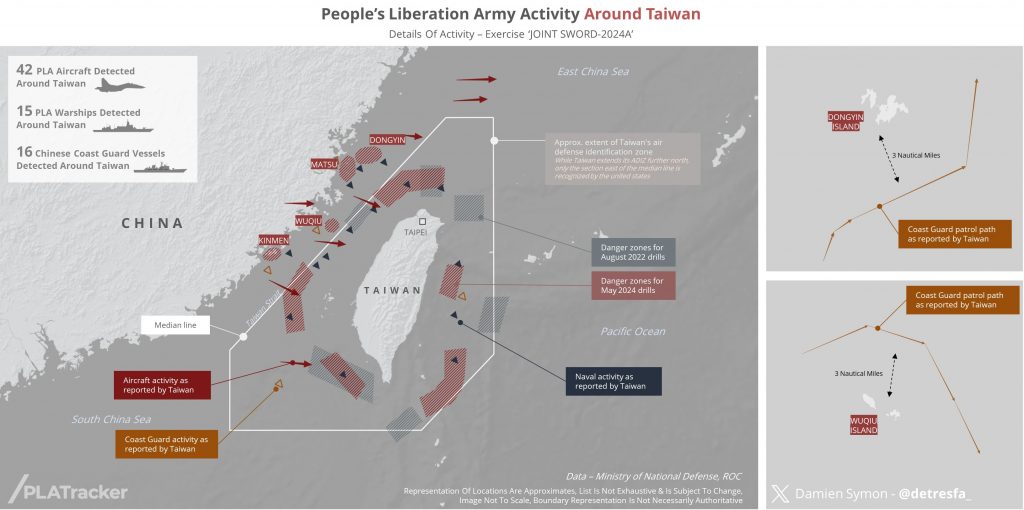Tensions Rise in the Taiwan Strait as China Conducts Military Exercises
In recent developments, there has been a noticeable increase in tensions over the Taiwan Strait. China has announced a significant military exercise aimed at targeting Taiwanese groups advocating for independence. This exercise, which China claims is a punitive measure, has raised concerns due to its strategic and aggressive nature.
The exercise is reminiscent of past maneuvers but with notable differences in execution and scale. Multiple zones around Taiwan have been designated for the exercise, likely causing disruptions to air travel, similar to previous incidents. Mapping data from P Tracker illustrates the differences between this exercise and past ones, with the current zones being closer to Taiwan’s eastern shores, encroaching significantly on Taiwanese waters.


Taiwan’s response has been to bolster its defenses, deploying surface-to-ship and surface-to-surface missiles across the island. This includes the deployment of Hsiung Feng II and Hsiung Feng III missiles, emphasizing a readiness to counter any aggressive moves by China.
On the sea, the situation is equally tense. The Taiwanese Coast Guard has encountered Chinese naval vessels, such as the Type 054A frigate, attempting to assert dominance near Taiwanese-controlled islands. These encounters highlight China’s disregard for Taiwan’s sovereignty, as China continues to assert its claim over Taiwan, considering it a part of the People’s Republic of China.
Taiwan has prepared extensively for potential conflict, drawing on its mountainous terrain and a strategy developed during the civil war era. The island’s defense includes secret tunnels, underground bases, and well-protected aircraft hangers within the mountains. This rugged terrain makes Taiwan a formidable challenge for any invading force.
The current military exercise by China, termed “United Sword 2024A,” involves various zones and significant naval and air force deployments. The Chinese Eastern Theater Command has stated that the exercise aims to punish Taiwan’s separatist activities and serves as a warning against external interference. Reports indicate that the exercise includes combined arms operations and patrols, with numerous naval vessels and aircraft participating.
In response, Taiwan’s Ministry of National Defense has condemned the exercises, describing them as undermining regional peace and stability. The Ministry affirmed Taiwan’s resolve to defend its sovereignty, calling for international condemnation of China’s actions.
Recent diplomatic activities in Taiwan, such as visits from foreign delegates and the establishment of diplomatic relationships with smaller nations, have likely contributed to China’s aggressive stance. These activities are perceived by China as provocations, further straining relations.
Despite the heightened tensions, the possibility of an all-out conflict remains uncertain. Taiwan’s preparedness and military capabilities serve as a deterrent, maintaining a balance of power in the region. By staying vigilant and ready, Taiwan aims to prevent any window of opportunity that China might exploit for a military operation.
As the situation continues to unfold, the world watches closely, hoping for a resolution that maintains peace and stability in the region. The Taiwan Strait remains a critical flashpoint with significant implications for global security.

